check engine PONTIAC VIBE 2010 Owner's Manual
[x] Cancel search | Manufacturer: PONTIAC, Model Year: 2010, Model line: VIBE, Model: PONTIAC VIBE 2010Pages: 318, PDF Size: 1.7 MB
Page 196 of 318

What to Do with Used Oil
Used engine oil contains certain
elements that can be unhealthy for
your skin and could even cause
cancer. Do not let used oil stay on
your skin for very long. Clean your
skin and nails with soap and water,
or a good hand cleaner. Wash or
properly dispose of clothing or rags
containing used engine oil. See the
manufacturer’s warnings about the
use and disposal of oil products.
Used oil can be a threat to the
environment. If you change your own
oil, be sure to drain all the oil from the
filter before disposal. Never dispose
of oil by putting it in the trash, pouring
it on the ground, into sewers, or into
streams or bodies of water. Recycle
it by taking it to a place that collects
used oil.
Automatic Transmission
Fluid
When to Check and Change
Automatic Transmission Fluid
Check the fluid in the transmission
and differential at the intervals listed
inScheduled Maintenance on
page 10-3, and be sure to use
the transmission fluid listed in
Recommended Fluids and
Lubricants on page 10-15 .
How to Check Automatic
Transmission Fluid
This operation can be difficult, you
may choose to have this done at the
dealer/retailer service department.
If you do it yourself, be sure to
follow all the instructions here,
or you could get a false reading
on the dipstick. Wait at least 30 minutes before
checking the transmission fluid level
if you have been driving:
•When outside temperatures are
above 90°F (32°C).
•At high speed for quite a while.
•In heavy traffic — especially
in hot weather.
•While pulling a trailer.
To get the right reading, the fluid
should be at normal operating
temperature, which is 158°F to
176°F (70°C to 80°C).
Get the vehicle warmed up by
driving about 15 miles (24 km)
when outside temperatures
are above 50°F (10°C). If it is
colder than 50°F (10°C), you
may have to drive longer.
9-12 Vehicle Care
Page 197 of 318

Checking the Fluid Level
Prepare your vehicle as follows:
1. Park your vehicle on a levelplace. Keep the engine running.
2. With the parking brake applied, place the shift lever in P (Park).
3. With your foot on the brake pedal, move the shift lever
through each gear range,
pausing for about three seconds
in each range. Then, position
the shift lever in P (Park).
4. Let the engine run at idle for three to five minutes. Then, without shutting off the
engine, follow these steps:
The automatic transmission
dipstick has an orange handle
and is located near the front of the
engine compartment. See
Engine
Compartment Overview on page 9-6
for more information on location.
1. Release the tab and pull out the dipstick and wipe it with a clean
rag or paper towel.
2. Push it back in all the way, wait three seconds and then pull it
back out again. 3. Check both sides of the dipstick,
and read the lower level. The
fluid level must be between the
two dimples in the hot range.
4. If the fluid level is in the acceptable range, push the
dipstick back in all the way;
then press the tab down to lock
the dipstick in place. 1.8L shown
Vehicle Care 9-13
Page 198 of 318
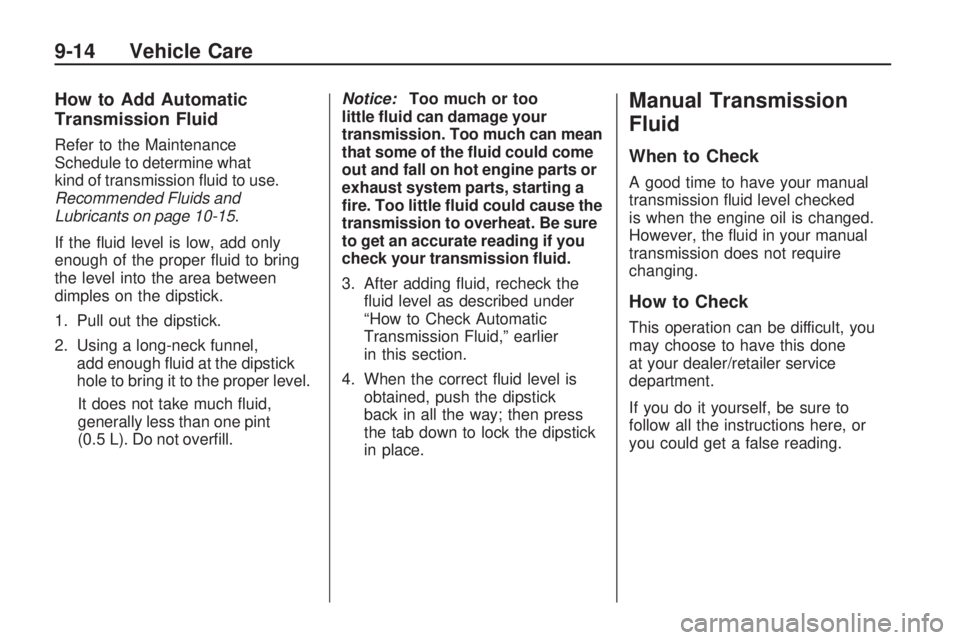
How to Add Automatic
Transmission Fluid
Refer to the Maintenance
Schedule to determine what
kind of transmission fluid to use.
Recommended Fluids and
Lubricants on page 10-15.
If the fluid level is low, add only
enough of the proper fluid to bring
the level into the area between
dimples on the dipstick.
1. Pull out the dipstick.
2. Using a long-neck funnel, add enough fluid at the dipstick
hole to bring it to the proper level.
It does not take much fluid,
generally less than one pint
(0.5 L). Do not overfill. Notice:
Too much or too
little �uid can damage your
transmission. Too much can mean
that some of the �uid could come
out and fall on hot engine parts or
exhaust system parts, starting a
�re. Too little �uid could cause the
transmission to overheat. Be sure
to get an accurate reading if you
check your transmission �uid.
3. After adding fluid, recheck the fluid level as described under
“How to Check Automatic
Transmission Fluid,” earlier
in this section.
4. When the correct fluid level is obtained, push the dipstick
back in all the way; then press
the tab down to lock the dipstick
in place.
Manual Transmission
Fluid
When to Check
A good time to have your manual
transmission fluid level checked
is when the engine oil is changed.
However, the fluid in your manual
transmission does not require
changing.
How to Check
This operation can be difficult, you
may choose to have this done
at your dealer/retailer service
department.
If you do it yourself, be sure to
follow all the instructions here, or
you could get a false reading.
9-14 Vehicle Care
Page 199 of 318

Notice:Too much or too
little �uid can damage your
transmission. Too much can mean
that some of the �uid could come
out and fall on hot engine parts or
exhaust system parts, starting a
�re. Too little �uid could cause the
transmission to overheat. Be sure
to get an accurate reading if you
check your transmission �uid.
Check the fluid level only when your
engine is off, the vehicle is parked on
a level place and the transmission
is cool enough for you to rest your
fingers on the transmission case.
Then, follow these steps:
1. Remove the filler plug.
2. Check that the lubricant level is up to the bottom of the filler
plug hole. 3. If the fluid level is good, install
the plug and be sure it is fully
seated. If the fluid level is low,
add more fluid as described in
the next steps.
How to Add Fluid
Here is how to add fluid. Refer
to the Maintenance Schedule
to determine what kind of fluid to
use. See Recommended Fluids
and Lubricants on page 10-15 .
1. Remove the filler plug.
2. Add fluid at the filler plug hole. Add only enough fluid to bring
the fluid level up to the bottom
of the filler plug hole.
3. Install the filler plug. Be sure the plug is fully seated.
Hydraulic Clutch
The hydraulic clutch linkage in your
vehicle is self-adjusting. The master
cylinder reservoir is filled with DOT-3
brake fluid.
It is not necessary to regularly
check the fluid unless you suspect
there is a leak in the system.
Adding fluid will not correct a leak.
The hydraulic clutch and brake
master cylinder use the same
reservoir.
A fluid loss in this system could
indicate a problem. Have the system
inspected and repaired.
Vehicle Care 9-15
Page 200 of 318
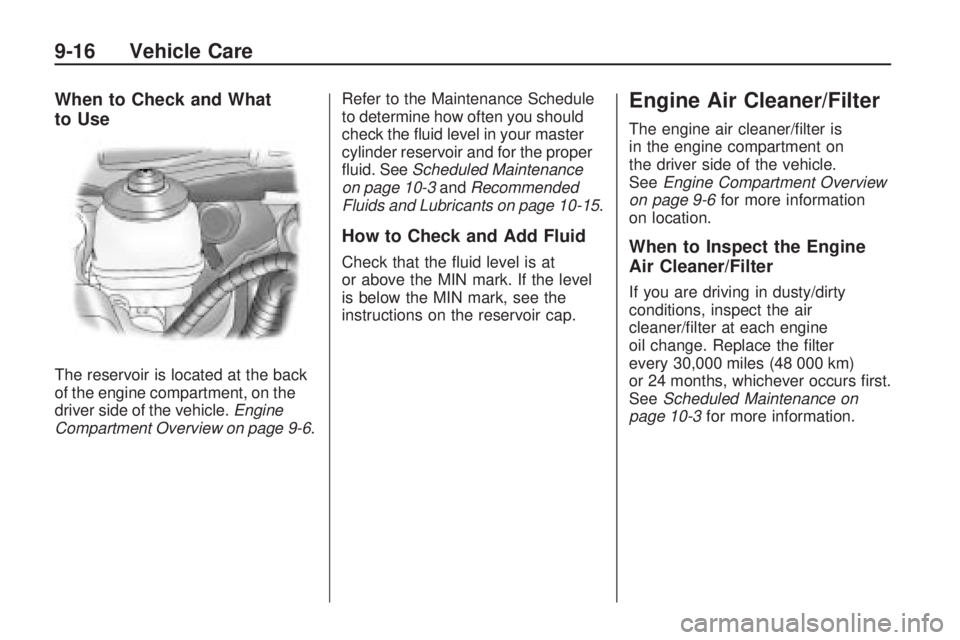
When to Check and What
to Use
The reservoir is located at the back
of the engine compartment, on the
driver side of the vehicle.Engine
Compartment Overview on page 9-6 .Refer to the Maintenance Schedule
to determine how often you should
check the fluid level in your master
cylinder reservoir and for the proper
fluid. See
Scheduled Maintenance
on page 10-3 andRecommended
Fluids and Lubricants on page 10-15 .
How to Check and Add Fluid
Check that the fluid level is at
or above the MIN mark. If the level
is below the MIN mark, see the
instructions on the reservoir cap.
Engine Air Cleaner/Filter
The engine air cleaner/filter is
in the engine compartment on
the driver side of the vehicle.
SeeEngine Compartment Overview
on page 9-6 for more information
on location.
When to Inspect the Engine
Air Cleaner/Filter
If you are driving in dusty/dirty
conditions, inspect the air
cleaner/filter at each engine
oil change. Replace the filter
every 30,000 miles (48 000 km)
or 24 months, whichever occurs first.
See Scheduled Maintenance on
page 10-3 for more information.
9-16 Vehicle Care
Page 204 of 318
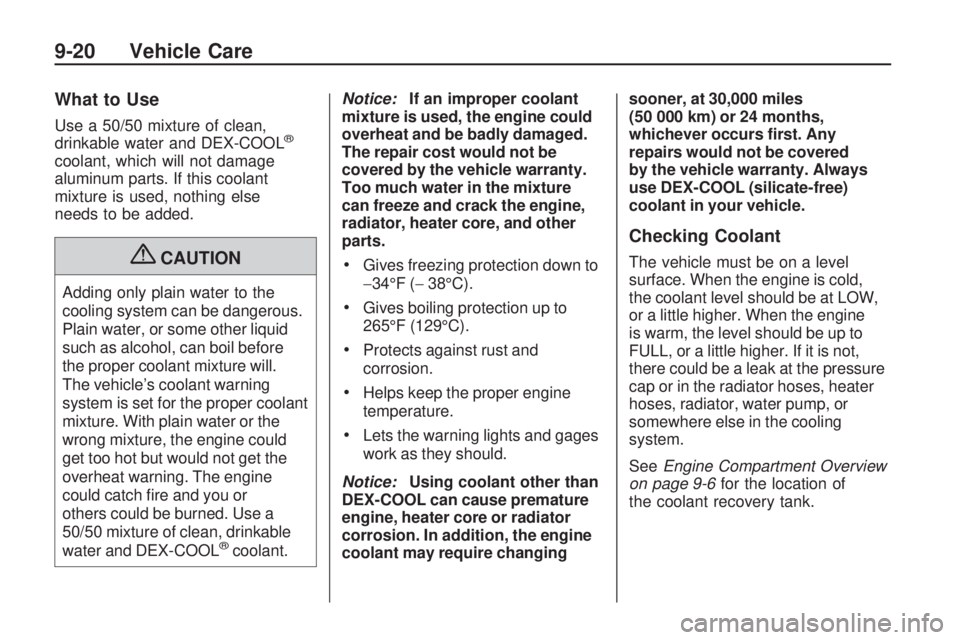
What to Use
Use a 50/50 mixture of clean,
drinkable water and DEX-COOL®
coolant, which will not damage
aluminum parts. If this coolant
mixture is used, nothing else
needs to be added.
{CAUTION
Adding only plain water to the
cooling system can be dangerous.
Plain water, or some other liquid
such as alcohol, can boil before
the proper coolant mixture will.
The vehicle’s coolant warning
system is set for the proper coolant
mixture. With plain water or the
wrong mixture, the engine could
get too hot but would not get the
overheat warning. The engine
could catch fire and you or
others could be burned. Use a
50/50 mixture of clean, drinkable
water and DEX-COOL
®coolant.Notice:
If an improper coolant
mixture is used, the engine could
overheat and be badly damaged.
The repair cost would not be
covered by the vehicle warranty.
Too much water in the mixture
can freeze and crack the engine,
radiator, heater core, and other
parts.
•Gives freezing protection down to
−34°F (− 38°C).
•Gives boiling protection up to
265°F (129°C).
•Protects against rust and
corrosion.
•Helps keep the proper engine
temperature.
•Lets the warning lights and gages
work as they should.
Notice: Using coolant other than
DEX-COOL can cause premature
engine, heater core or radiator
corrosion. In addition, the engine
coolant may require changing sooner, at 30,000 miles
(50 000 km) or 24 months,
whichever occurs �rst. Any
repairs would not be covered
by the vehicle warranty. Always
use DEX-COOL (silicate-free)
coolant in your vehicle.
Checking Coolant
The vehicle must be on a level
surface. When the engine is cold,
the coolant level should be at LOW,
or a little higher. When the engine
is warm, the level should be up to
FULL, or a little higher. If it is not,
there could be a leak at the pressure
cap or in the radiator hoses, heater
hoses, radiator, water pump, or
somewhere else in the cooling
system.
See
Engine Compartment Overview
on page 9-6 for the location of
the coolant recovery tank.
9-20 Vehicle Care
Page 205 of 318
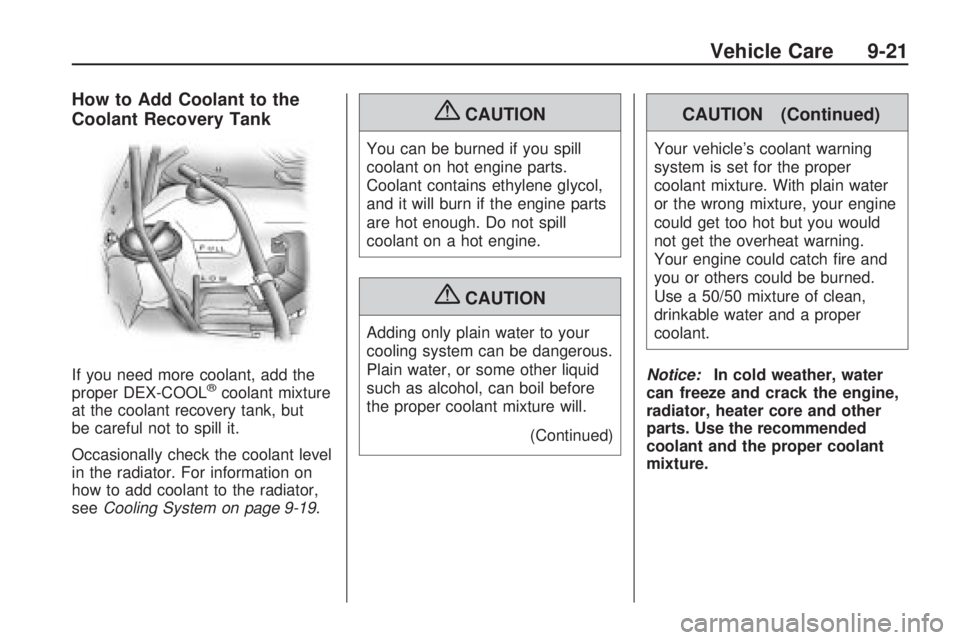
How to Add Coolant to the
Coolant Recovery Tank
If you need more coolant, add the
proper DEX-COOL®coolant mixture
at the coolant recovery tank, but
be careful not to spill it.
Occasionally check the coolant level
in the radiator. For information on
how to add coolant to the radiator,
see Cooling System on page 9-19 .
{CAUTION
You can be burned if you spill
coolant on hot engine parts.
Coolant contains ethylene glycol,
and it will burn if the engine parts
are hot enough. Do not spill
coolant on a hot engine.
{CAUTION
Adding only plain water to your
cooling system can be dangerous.
Plain water, or some other liquid
such as alcohol, can boil before
the proper coolant mixture will.
(Continued)
CAUTION (Continued)
Your vehicle’s coolant warning
system is set for the proper
coolant mixture. With plain water
or the wrong mixture, your engine
could get too hot but you would
not get the overheat warning.
Your engine could catch fire and
you or others could be burned.
Use a 50/50 mixture of clean,
drinkable water and a proper
coolant.
Notice: In cold weather, water
can freeze and crack the engine,
radiator, heater core and other
parts. Use the recommended
coolant and the proper coolant
mixture.
Vehicle Care 9-21
Page 207 of 318
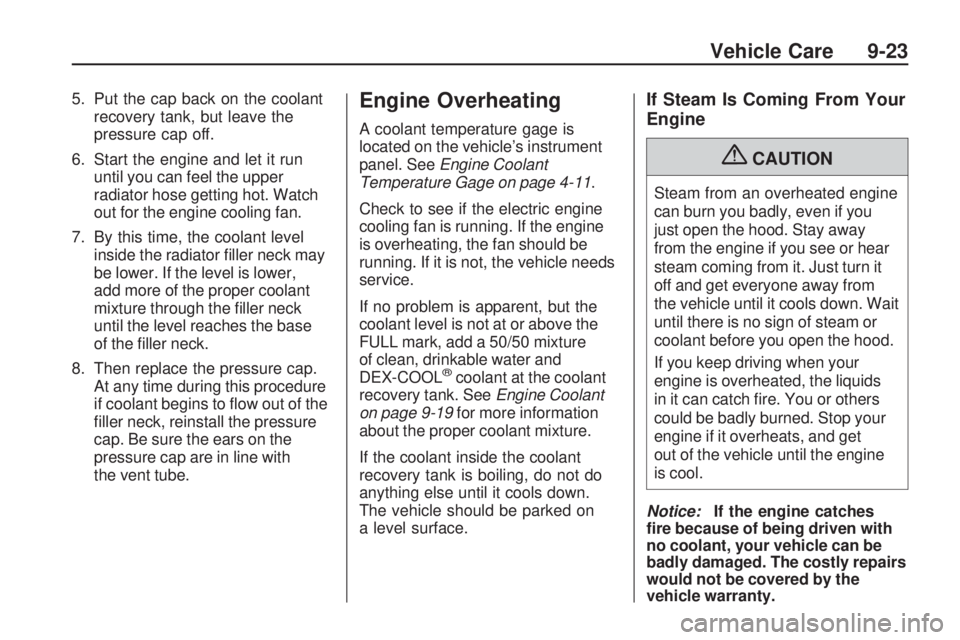
5. Put the cap back on the coolantrecovery tank, but leave the
pressure cap off.
6. Start the engine and let it run until you can feel the upper
radiator hose getting hot. Watch
out for the engine cooling fan.
7. By this time, the coolant level inside the radiator filler neck may
be lower. If the level is lower,
add more of the proper coolant
mixture through the filler neck
until the level reaches the base
of the filler neck.
8. Then replace the pressure cap. At any time during this procedure
if coolant begins to flow out of the
filler neck, reinstall the pressure
cap. Be sure the ears on the
pressure cap are in line with
the vent tube.Engine Overheating
A coolant temperature gage is
located on the vehicle’s instrument
panel. See Engine Coolant
Temperature Gage on page 4-11 .
Check to see if the electric engine
cooling fan is running. If the engine
is overheating, the fan should be
running. If it is not, the vehicle needs
service.
If no problem is apparent, but the
coolant level is not at or above the
FULL mark, add a 50/50 mixture
of clean, drinkable water and
DEX-COOL
®coolant at the coolant
recovery tank. See Engine Coolant
on page 9-19 for more information
about the proper coolant mixture.
If the coolant inside the coolant
recovery tank is boiling, do not do
anything else until it cools down.
The vehicle should be parked on
a level surface.
If Steam Is Coming From Your
Engine
{CAUTION
Steam from an overheated engine
can burn you badly, even if you
just open the hood. Stay away
from the engine if you see or hear
steam coming from it. Just turn it
off and get everyone away from
the vehicle until it cools down. Wait
until there is no sign of steam or
coolant before you open the hood.
If you keep driving when your
engine is overheated, the liquids
in it can catch fire. You or others
could be badly burned. Stop your
engine if it overheats, and get
out of the vehicle until the engine
is cool.
Notice: If the engine catches
�re because of being driven with
no coolant, your vehicle can be
badly damaged. The costly repairs
would not be covered by the
vehicle warranty.
Vehicle Care 9-23
Page 209 of 318

How to Check Windshield
Washer Fluid
To check windshield washer fluid.
1. Pull dipstick out of windshieldwasher reservoir.
2. Washer fluid should fill the holes between the LOW (B) and
NORMAL (A) mark.
3. If the fluid reads LOW (B) add fluid.
Adding Washer Fluid
Open the cap with the washer
symbol on it. Add washer fluid
until the holes of the dipstick
are filled between the LOW (B)
and NORMAL (A). See Engine
Compartment Overview on
page 9-6 for reservoir location.
Notice:
When using concentrated
washer �uid, follow the
manufacturer’s instructions
for adding water.
Do not mix water with
ready-to-use washer �uid.
Water can cause the solution
to freeze and damage your
washer �uid tank and other
parts of the washer system.
Also, water does not clean
as well as washer �uid.
Fill the washer �uid tank only
three-quarters full when it is
very cold. This allows for �uid
expansion if freezing occurs,
which could damage the tank
if it is completely full.
Do not use engine coolant
(antifreeze) in your windshield
washer. It can damage the
vehicle’s windshield washer
system and paint.
Vehicle Care 9-25
Page 214 of 318

Starter Switch Check
{CAUTION
When you are doing this
inspection, the vehicle could move
suddenly. If the vehicle moves,
you or others could be injured.
1. Before starting this check, be sure there is enough room
around the vehicle.
2. Firmly apply both the parking brake and the regular brake.
See Parking Brake on page 8-33 .
Do not use the accelerator
pedal, and be ready to turn off
the engine immediately if it starts. 3. For automatic transmission
vehicles, try to start the engine
in each gear. The vehicle
should start only in P (Park) or
N (Neutral). If the vehicle starts
in any other position, contact
your dealer/retailer for service.
For manual transmission
vehicles, put the shift lever in
Neutral, push the clutch pedal
down halfway, and try to start the
engine. The vehicle should start
only when the clutch pedal is
pushed down all the way to the
floor. If the vehicle starts when
the clutch pedal is not pushed
all the way down, contact your
dealer/retailer for service.
Wiper Blade
Replacement
Front Windshield Wiper
Windshield wiper blades should
be inspected at least twice a year
for wear or cracking.
Replacement blades come in
different types and are removed
in different ways. To remove
the wiper blade:
1. Pull the windshield wiper arm away from the windshield.
9-30 Vehicle Care